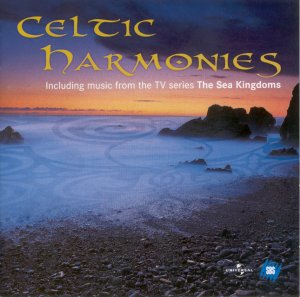This CD is a spin-off from the TV series The Sea Kingdoms
the score for which takes up the first seven tracks. Phil Cunningham
wrote and performed the score which in total plays for 19.16. The
playing time is fleshed out with four tracks by the Breton, Alan
Stivell. These date from the early 1970s long before the renaissance
in interest in all things Celtic. Sean Davey's Brendan Voyages,
River Dance, Capercaillie (the most natural and original voices
in the Gaelic resurgence), The Chieftains, Howard Shore's and Enya's
scores for The Lord of the Rings, Runrig, Rob Roy, Brave Heart and
The Corrs all fan the flame and live off the fascination.
Phil Cunningham's breathy amalgam of whale calls (well used previously
by Alan Hovhaness in his piece And God Created Great Whales),
spotlit flute, 'harp pattering' and wisps of breathy ceremonial
singing works very well. Religious Bell (tr.2) mixes the bardic
singing of Carolan within a note pattern that links with Nyman's
score for The Piano. War (tr.3) is akin to the sounds from early
Capercaillie albums with a touch of that classic of the genre,
Sean Davey's Granuaile (with the incomparable voice of Rita Connolly)
- an album that should be in everyone's collection. The softly
breath-warbled and invocational piping of Early Religion (end
of tr. 4) makes a haunted and haunting sound - the essence of
rain, soft days, ruined fastnesses, moss and peat fires. Druids
- The Castle - Vikings (tr.5) is the oddest track serving its
illustrative purpose well. The Language of the Celts (tr. 6) muses
in calm reflection. Nostalgia (tr. 7) takes us back to the breathy
flute-articulated homesickness. The four Stivell brevities lead
us through grief, beauty, fabled lands, innocence and dusty glories
relived or imagined. These tracks are either celtic harp alone
or accompanied or preluded by flute (Airde Cuan), sampled voices
(Eliz Iza - the most synthetic sounded of the four tracks) or
the bodhran in Suite Irlandaise.
The Secret Garden/Rolf Lovland tracks (10, 14) have, amongst
much else, Fionnuala Sherry's violin and Davey Spillane's Uillean
pipes. Elegie involves a large number of players with Anúna,
the Irish National Symphony Orchestra and the RTE Concert Players
in a gentle populist confection. The Hymn to Hope is less commercial
- for the most part attaining simplicity around a tune that drifts
between Moon River on one side and Bring in the Clowns on the
other.
The Minstrel Boy is a suave instrumental 1996 Corrs track which
becomes more synthetic and steeped in caramel and Guinness as
the track plays on. Brian Dullaghan's Little Fairy must have been
a lusty, dewy-eyed creature to conjure music of this brightness
- much more attractive.
The Bantock piece represents a major stylistic gear-change. This
is a 'classical' piece in which the harps, though numerous, are
used in a tactful concert hall balance. In the process of recording
everything is contrived. Here however the effect is natural without
obvious spotlighting of the harps. They get their big moment though
in the Largamente maestoso with their rolling bullish arpeggios.
These have nothing to do with the Gaelic harp and more to do with
the cinema as in Bernard Herrmann's lushly optimistic music for
the film Beyond the Twelve Mile Reef. By the way Bantock wrote
quite a few other Celtic themed works including Sea Wanderers,
Hebridean Symphony and the Sea Reivers. Having heard the Celtic
Symphony do have a look at other Bantock orchestral discs in the
Hyperion catalogue … though none prescribe six harps.
This is an album relying on the expected popularity of a TV series
(surely to be syndicated worldwide?) but it stands well on its
own attractive merits. Outstanding are the Phil Cunningham, Stivell
and Dullaghan tracks.
There are no notes though very full artist and track listings.
Rob Barnett
